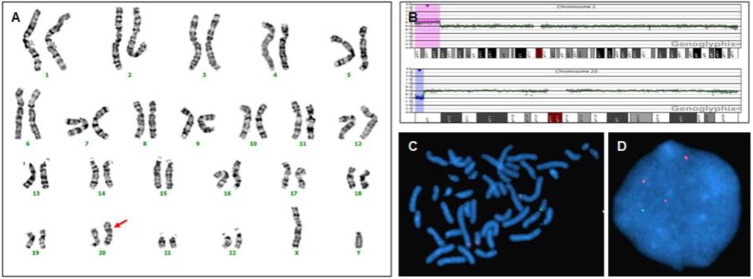Introduction
Materials and methods
1. Patients
2. Array CGH and confirmatory tests
3. Other diagnostic tests
Results
1. Clinical characteristics of patients
2. Result of array CGH and G-banded karyotyping
Table 1
Clinical and genetic features in 5 patients who showed pathogenic copy number variations and variants of uncertain significance in array comparative genomic hybridization
CGH, comparative genomic hybridization; OMIM, Online Mendelian Inheritance in Man; GDD, global developmental delay; DD, developmental delay; VUS, variants of uncertain significance; FISH, fluorescence in situ hybridization; qPCR, real-time quantitative polymerase chain reaction.
*Age at the time of genetic testing.
 |
Fig. 1Genetic features of patient 1. (A) G-banded karyotyping shows 46,XY,dup(20)(p13) (arrow). (B) Array comparative genomic hybridization shows an 18.73-Mb duplication of 2p24.2-2p25.3 (red region) and 1.62-Mb deletion of 20p13 (blue region), (C, D) Fluorescence in situ hybridization indicates a rearrangement resulting from fusion of the duplicated 2p terminal to the deleted 20p terminal. Bacterial artificial chromosome (BAC) RP11-480N14 (red) harbors the 2p24.3 location and BAC RP11-314N13 (green) harbors the 20p13 location. |
 |
Fig. 2Genetic features of patient 2. (A) G-banded karyotyping shows 46,XY,dup(2)(p21p25.1) in this panel (arrow). However, patient 2 had low-level mosaicism (11.5%) of 46,XY,dup(2)(p21p25.1[177]/46,XY,del(2)(p22p23)[23]) in G-banded karyotyping. (B) Array comparative genomic hybridization (CGH) shows a 22.31-Mb duplication of 2p22.3-2p25.1 and 4.01-Mb duplication of 2p21-2p22.1 (red regions). Array CGH analysis did not show low-level mosaicism, but was able to identify that the large duplication of dup(2)(p21p25.1) observed in G-banded karyotyping was actually composed of two separate duplications (2p21-2p22.1 and 2p22.3-2p25.1), whereas the copy number of the intermediate genomic sequence was normal. (C) Fluorescence in situ hybridization (FISH) indicates 2p24.3 duplication (RP11-480N14, red color), and normal copy number of 2q22.3 (RP11-141C15, green color). (D) FISH also indicates 2p21 duplication (RP11-20A12, red color). |



 PDF Links
PDF Links PubReader
PubReader ePub Link
ePub Link PubMed
PubMed Download Citation
Download Citation


